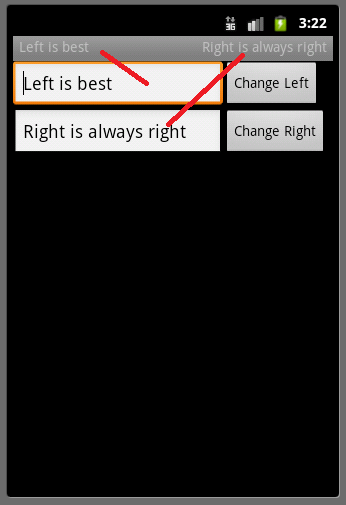編輯:Android開發教程
Android UI缺省的標題欄由android:label 定義,顯示在屏幕左上角,Android允許Activity自定義標題欄,使用自定義 Layout重新設置標題欄,比如實現Windows Mobile 風格的標題欄。
App->Activity->Custom Title 重新將 Activity標題欄定義為左右兩個文本框,其Layout定義R.layout.custom_title_1如下
<RelativeLayout xmlns:android=”http://schemas.android.com/apk/res/android” android:id=”@+id/screen” android:layout_width=”match_parent” android:layout_height=”match_parent” android:orientation=”vertical”> <TextView android:id=”@+id/left_text” android:layout_width=”wrap_content” android:layout_height=”wrap_content” android:layout_alignParentLeft=”true” android:text=”@string/custom_title_left” /> <TextView android:id=”@+id/right_text” android:layout_width=”wrap_content” android:layout_height=”wrap_content” android:layout_alignParentRight=”true” android:text=”@string/custom_title_right” /> </RelativeLayout>
為一左一右兩個文本框。
於每個Activity對應的除了使用由setContentView設置的 Content View之外,還有一個Windows類對象,Windows 類對象用於控制標題欄,可以允許自定義標題欄或是不顯示標題欄。
Windows 定義了一些Feature,允許開發人員做些定制:自定義標題欄對應的Feature ID為 Window.FEATURE_CUSTOM_TITLE
requestWindowFeature(Window.FEATURE_CUSTOM_TITLE); setContentView(R.layout.custom_title); getWindow().setFeatureInt(Window.FEATURE_CUSTOM_TITLE, R.layout.custom_title_1);

 Android開發入門(一)詳解活動 1.3 隱藏Activity的標題
Android開發入門(一)詳解活動 1.3 隱藏Activity的標題
如果願意的話,可以把Activity的標題欄給隱藏了。只需要調用requestWindowFeature()方法,同時傳遞 Window.FEATURE_NO_TITLE
 Android測試教程(12):ServiceTestCase示例
Android測試教程(12):ServiceTestCase示例
ServiceTestCase 為測試Service提供了一個可控的測試環境,它提供對Service 生命周期的基本支持,並可以通過注入一些 依賴對象來控制測試環境以便測
 Android中Log用法詳解
Android中Log用法詳解
android.util.Log常用的方法有以下5個:Log.v() Log.d() Log.i() Log.w() 以及 Log.e() 。根據首字母對應VERBOSE
 android技巧:如何在android程序中執行adb shell命令
android技巧:如何在android程序中執行adb shell命令
package net.gimite.nativeexe; import java.io.BufferedReader; import java.io.F